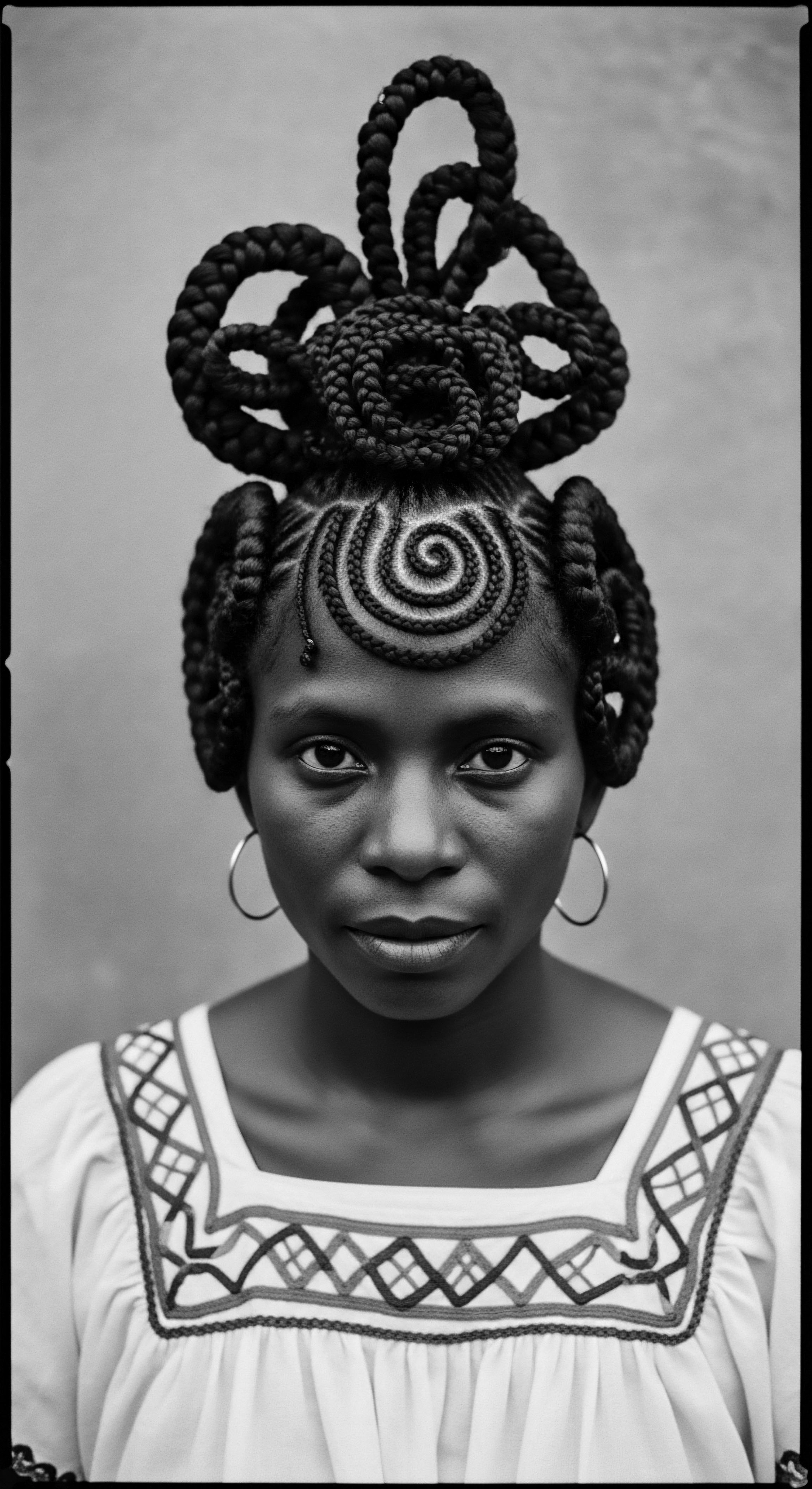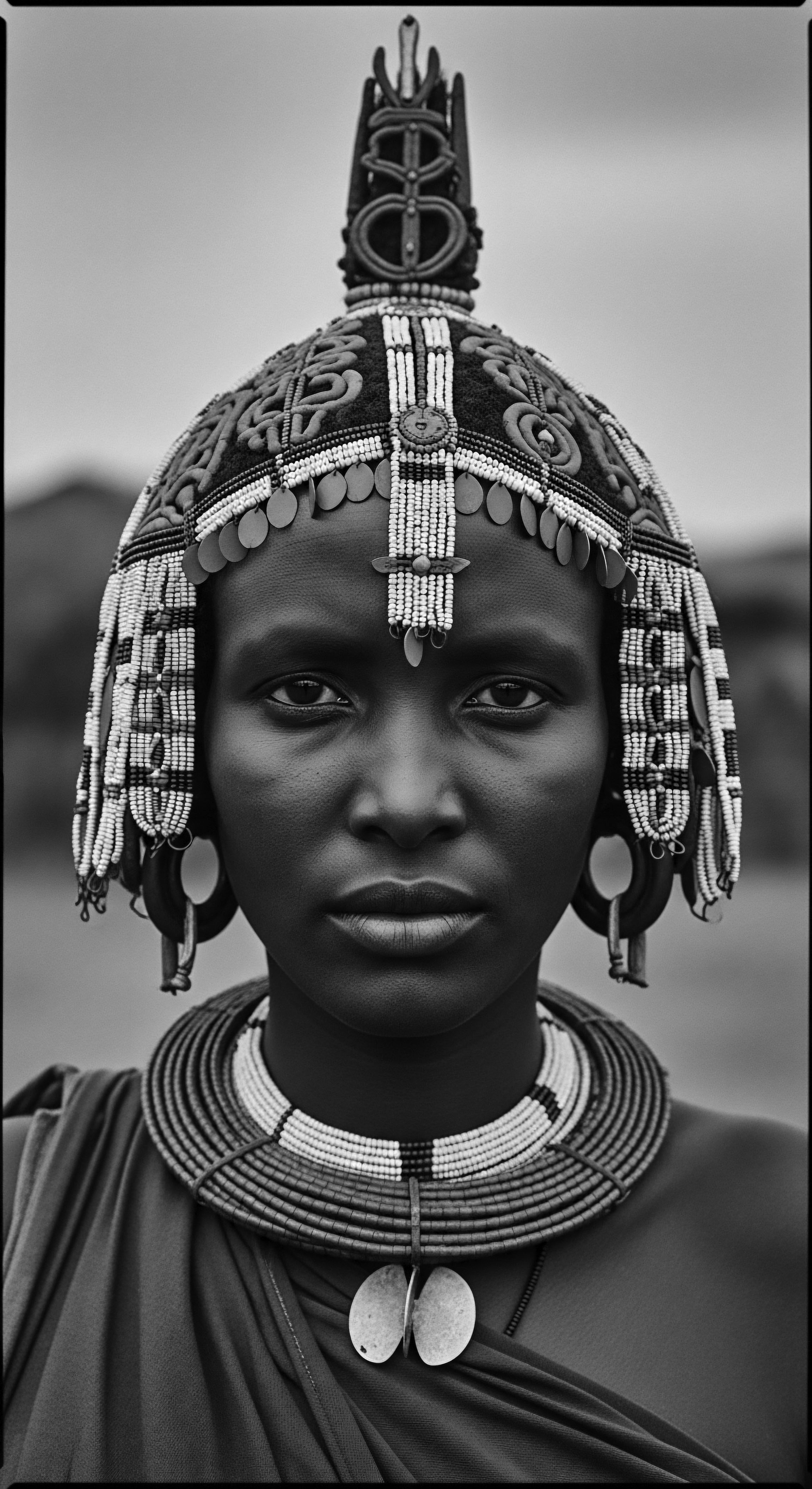
Roots
The story of textured hair is not merely a biological account; it is a profound journey woven through generations, a testament to resilience, artistry, and deep-seated cultural wisdom. It speaks of ancestral whispers carried on desert winds, of sun-drenched rituals, and of a heritage often misunderstood, yet always enduring. Within this vast chronicle, certain elements stand as luminous guardians of tradition, their significance stretching far beyond the mundane. One such guardian, a secret held close by the Basara women of Chad for millennia, is chébé powder.
Consider, for a moment, the very structure of textured hair itself. Its spirals, coils, and waves are masterpieces of nature, each turn a potential point of fragility. Unlike straighter strands, the natural oils produced by the scalp struggle to descend the intricate path of a coiled hair shaft, leaving the ends particularly prone to dryness.
This inherent thirst, when unmet, can lead to breakage, making the pursuit of length a continuous challenge. For countless generations, communities with highly textured hair developed ingenious methods to counteract these tendencies, recognizing that care was not simply about appearance, but about sustenance, preservation, and a connection to the very life force.
The historical understanding of hair anatomy, while not articulated in modern scientific terms, was nonetheless deeply practical. Ancestral practitioners observed the hair’s tendency to break, its response to moisture, and its vulnerability to environmental stressors. This observational wisdom informed the development of localized solutions, often drawing directly from the surrounding natural world.
Chébé, derived from the seeds of the Croton Zambesicus plant, also known as Lavender Croton, is a testament to this astute perception. Its application wasn’t random; it was a deliberate response to the specific needs of textured hair, aiming to shield its delicate architecture from the rigors of life in the Sahel region of Africa.

The Essential Lexicon of Textured Hair
The language surrounding textured hair is as rich and varied as the hair itself, reflecting its diverse heritage. Understanding its vocabulary deepens our connection to its care and its history.
- Coil ❉ A tightly wound spiral pattern, characteristic of many Afro-textured hair types. These coils can be quite delicate and prone to shrinking.
- Kink ❉ A sharp, tight bend or zigzag in the hair strand, often found in patterns that resist elongation.
- Hair Porosity ❉ The ability of the hair shaft to absorb and retain moisture. Textured hair often exhibits varying levels of porosity, influencing how products are best absorbed.
- Length Retention ❉ The capacity of hair to maintain its growth over time by reducing breakage. Chébé powder is renowned for its specific qualities in this area.
This traditional knowledge, passed from elder to youth, transcended mere description. It informed specific care strategies, each term guiding a gentle hand or a purposeful application. The understanding that hair length was often lost through breakage, rather than a lack of growth from the scalp, was a profound ancient insight. Chébé powder, by coating the hair shaft and retaining moisture, directly addressed this central challenge, offering a protective embrace that allowed for genuine length retention.
Chébé powder, a timeless secret from Chad, provides a nurturing shield for textured hair, helping preserve its intrinsic strength and promoting its natural growth.

How Does Chébé Support Hair’s Structure?
The effectiveness of chébé powder, observed and documented through centuries of practice, speaks to a deeply intuitive understanding of textured hair’s unique biology. While not a direct hair growth stimulant for the scalp, its strength lies in its ability to fortify the existing hair strands. The complex mixture of ingredients, including the primary Croton Zambesicus seeds, along with mahllaba soubiane (cherry kernels), cloves, resin, and stone scent, works in concert. These components, when ground and blended, create a substance that clings to the hair shaft, effectively forming a protective barrier.
This barrier acts as a physical shield, minimizing the impact of environmental factors like sun and dust, which can otherwise lead to dryness and brittleness. More significantly, it helps to lock in moisture that is applied to the hair, preventing its rapid escape from the porous outer cuticle. This sustained hydration is consequential for coiled and kinky hair types, which, as previously mentioned, tend to be drier due to the structural impediment to sebum distribution along the hair shaft.
By maintaining this moisture, chébé helps keep the hair supple and elastic, drastically reducing the likelihood of breakage, split ends, and tangling. This protective action allows the hair to reach its full genetic length potential, a characteristic deeply admired and historically significant within the Basara community and beyond.

Ritual
The application of chébé powder has always been more than a simple beauty routine; it is a ritual, a communal gathering, and a ceremonial act steeped in the heritage of the Basara women of Chad. This tradition, passed from mother to daughter across countless generations, speaks to a profound connection between self-care, community, and the ancestral wisdom that informs both. The very act of preparing and applying chébé is a celebration of shared identity, a quiet assertion of beauty standards forged within the community, rather than dictated by external influences.
In Chad, the traditional method involves an intricate process, often spanning days. The powder, a fine blend of roasted and ground seeds and herbs, is mixed with nourishing oils or rich butters. This creates a paste, which is then applied to damp, sectioned hair. Each strand, from near the roots to the very ends, receives a coat of this reddish-brown mixture.
The hair is then typically braided, providing a protective style that allows the chébé mixture to remain on the strands for an extended period, sometimes for several days, before being re-wet and reapplied. This method ensures consistent moisture retention and fortification of the hair shaft, reflecting a deep, practical understanding of hair health.

Traditional Styling Influences
Chébé’s role extends directly into the art of traditional styling. The very act of braiding, a foundational practice in African hair heritage, is often intertwined with the application of chébé. Braids, beyond their aesthetic appeal, serve as a protective shield, minimizing manipulation and exposure to harsh elements.
The chébé paste, applied before braiding, seals in moisture and strengthens the hair, making it more resilient within these protective styles. This synergy between product and style allows the hair to maintain its integrity, leading to impressive length retention, a hallmark of the Basara women.
The ‘Gourone’ hairstyle, consisting of several large, thick plaits and thinner braids, is one such traditional style frequently paired with the chébé treatment. These styles are not simply static adornments; they are living expressions of culture and continuity. The creation of such styles, often performed by skilled hands of older women, becomes a moment for storytelling, laughter, and the transmission of values. This communal aspect ensures that the knowledge of chébé, and the broader heritage of hair care, remains vibrant and alive within the community.
The chébé ritual embodies a collective wisdom, transforming daily hair care into a ceremonial celebration of shared culture and intergenerational knowledge.

What Are the Essential Tools of Traditional Chébé Application?
The practice of chébé application, while seemingly simple, involves a specific set of tools and preparations that have been refined over centuries. These implements, often crafted from natural materials, are an extension of the hands that apply the nourishing paste, connecting the present moment of care to a distant past.
- Grinding Stones or Mortar and Pestle ❉ Essential for pulverizing the sun-dried chébé seeds and other ingredients into a fine powder. This process itself is a labor of love, speaking to the dedication invested in traditional preparation.
- Mixing Bowls ❉ Typically made from natural materials, these bowls hold the chébé powder as it is combined with various oils and butters to create the paste.
- Combs or Fingers for Sectioning ❉ Hair is meticulously divided into sections, ensuring that every part of the hair shaft receives an even application of the mixture. This methodical approach speaks to the precision and thoroughness of traditional care.
These tools, while practical, also hold symbolic weight. They represent the ingenuity and resourcefulness of a community that has long understood the earth’s offerings as sustenance for body and spirit. The act of preparing the chébé, from roasting the seeds to grinding them, becomes a foundational step in the ritual, a period of anticipation and intention setting.
| Ingredient Croton Zambesicus (Chébé Seeds) |
| Traditional Role in Chébé Primary component, provides strengthening and moisture-retention properties. |
| Broader Heritage Significance Grows wild in Chad's mountainous regions, a direct link to the local ecosystem and ancestral resourcefulness. |
| Ingredient Mahllaba Soubiane (Cherry Kernels) |
| Traditional Role in Chébé Adds fragrance and conditioning qualities. |
| Broader Heritage Significance Represents the holistic approach to beauty, where sensory experience is integral to the ritual. |
| Ingredient Cloves |
| Traditional Role in Chébé Contributes fragrance; known for antifungal properties beneficial for scalp health. |
| Broader Heritage Significance A widely used spice in many African cultures, reflecting broader historical trade routes and medicinal knowledge. |
| Ingredient Resin |
| Traditional Role in Chébé Aids in the consistency of the paste, helping it adhere to the hair shaft. |
| Broader Heritage Significance Connects to natural exudates from trees, traditionally used for various purposes including sealing and binding. |
| Ingredient Stone Scent (Missic Stone) |
| Traditional Role in Chébé Adds aroma and may have exfoliating properties. |
| Broader Heritage Significance A mineral component, signifying the ancient practice of incorporating earth's elements into wellness. |
| Ingredient These components collectively form chébé powder, a powerful testament to the intergenerational wisdom of the Basara women. |

Relay
The enduring legacy of chébé powder, particularly its connection to textured hair heritage , speaks volumes about the wisdom passed down through generations. It is a living example of how ancestral knowledge, refined through centuries of observation and practice, often aligns with, and in some ways anticipates, modern scientific understanding. For the women of the Basara tribe in Chad, their long, strong hair is not a mere aesthetic preference; it is a cultural marker, a source of pride, and a testament to a traditional hair care system that has sustained them for an extraordinary length of time.
The persistence of the chébé tradition is quite remarkable. Anthropological studies from the University of Cairo have documented the methods by which Chadian women maintain their hair length, despite the harsh desert conditions that would typically lead to severe dryness and breakage (WholEmollient, 2025). This enduring practice, dating back at least 7,000 to 8,000 years, represents an almost unparalleled continuity in hair care traditions.
Such a long history of use provides a powerful signal of its efficacy within the context of textured hair . This is a system that has been tested and refined by successive generations, proving its worth far beyond anecdotal claims.

How Does Ancestral Wisdom Align With Modern Science of Chébé?
From a scientific perspective, the benefits attributed to chébé powder by its traditional users find resonance in contemporary understanding of hair biology. While initial scientific research specific to chébé’s hair benefits remains somewhat limited compared to its extensive traditional use, existing studies and chemical analyses offer compelling insights into its protective mechanisms. The ingredients in chébé are rich in compounds that support hair health.
For instance, the Croton zambesicus seeds themselves contain essential fatty acids, amino acids, and minerals. These components are vital for maintaining the hair’s structural integrity.
When chébé paste is applied to the hair shaft, the natural crystalline waxes present in the mixture help to seal the hair cuticle. This sealing action is critical for retaining moisture, a particular challenge for highly textured hair due to its unique coil patterns that impede the natural distribution of sebum. By locking in moisture, the hair remains hydrated, improving its elasticity and significantly reducing its susceptibility to breakage. The presence of triglycerides further aids in penetrating the hair shaft, providing deeper conditioning, while antioxidants offer protection against environmental damage.
Trace minerals contribute to the overall keratin structure of the hair, reinforcing its inherent strength. This scientific lens validates the centuries-old observations of the Basara women, who knew, through repeated practice, that chébé strengthened their hair and allowed it to flourish.
The enduring practice of chébé application by Chadian women offers a compelling case study of traditional knowledge, providing a natural blueprint for length retention for textured hair.

Beyond Biology What Are Chébé’s Cultural Dimensions?
Beyond the purely scientific and practical aspects, the cultural dimensions of chébé powder are equally significant, anchoring it firmly within textured hair heritage . The ritualistic application of chébé is a profound act of cultural transmission. It is a communal experience, often involving older women guiding younger members, sharing stories and laughter, transforming a grooming task into a joyful bonding occasion. This intergenerational exchange ensures the continuity of not just the practice, but also the values, history, and identity associated with it.
The act of applying chébé can represent a rite of passage, marking milestones such as a young girl’s transition into womanhood or the celebration of motherhood. In these moments, hair becomes a visible symbol of life, vitality, and connection to ancestry. During times of immense historical disruption, such as the transatlantic slave trade, the forced shaving of hair was a deliberate attempt to strip individuals of their cultural identity and sever ties to their ancestral practices.
Conversely, the preservation and resurgence of traditional hair care practices, including those centered on ingredients like chébé, serve as powerful acts of resistance and affirmation of Black and mixed-race cultural legacies . Hair, in this context, becomes a canvas for self-definition and pride.
The global resurgence of interest in chébé powder, particularly within the natural hair movement, highlights a yearning for holistic, traditionally informed solutions that honor hair’s authentic texture. It points to a broader cultural movement towards reclaiming and celebrating African hair heritage , moving away from Eurocentric beauty standards that historically promoted chemical alteration.
| Historical/Traditional Period Ancient/Pre-Colonial Africa (7,000-8,000 years ago to 15th Century) |
| Impact on Hair Heritage via Chébé Foundation of length retention for Basara women; cultural significance as a symbol of beauty, vitality, and identity. |
| Contemporary Connection to Chébé's Legacy The enduring knowledge base for chébé use continues to inform authentic product formulations and cultural practices. |
| Historical/Traditional Period Colonial Era and Beyond (16th-20th Century) |
| Impact on Hair Heritage via Chébé Preservation of traditional practices despite external pressures; a subtle act of cultural resistance. |
| Contemporary Connection to Chébé's Legacy Inspires contemporary movements toward natural hair and reclamation of ancestral beauty rituals. |
| Historical/Traditional Period Modern Era (Late 20th Century – Present) |
| Impact on Hair Heritage via Chébé Global recognition and demand for traditional African hair secrets; renewed pride in textured hair identity. |
| Contemporary Connection to Chébé's Legacy Modern brands seek ethical sourcing and community partnerships, respecting the origins of chébé and its associated heritage. |
| Historical/Traditional Period Chébé powder stands as a testament to the continuous thread of hair heritage, adapting and influencing hair care across historical epochs. |

What Challenges Persist in Globalizing Traditional Knowledge?
As chébé powder gains global recognition, new challenges arise in ensuring that its journey from traditional use to international prominence is respectful and equitable. The widespread popularity has, unfortunately, led to the appearance of counterfeit products. This underscores the importance of sourcing authentic chébé, which typically has a granular, slightly rough texture and a dark brown or reddish hue with a distinctive earthy, herbal scent. The global market also presents questions of intellectual property and fair compensation for the communities who have preserved this wisdom for millennia.
Organizations and brands seeking to market chébé-based products now bear a responsibility to partner directly with Chadian communities, ensuring that proceeds financially benefit those who are the custodians of this sacred knowledge. Examples of this ethical sourcing exist, where a portion of sales are directed back to the communities, providing economic benefit and affirming the value of their cultural patrimony. Such partnerships honor the intricate relationship between product, people, and heritage, establishing a model for a more conscientious beauty industry.

Reflection
To walk the path of textured hair care, especially when guided by ancestral wisdom, is to step into a living archive. Chébé powder, from its quiet origins in the heart of Chad, stands as a luminous page in this ongoing story. It is a testament to the enduring power of observation, the quiet genius of tradition, and the profound connection between earth, community, and the human spirit. The whispers of the Basara women, carried on the wind, remind us that the deepest truths about wellbeing often reside in the simplest, most time-honored practices.
The journey of chébé, from elemental plant to revered hair elixir, echoes the journey of textured hair itself – from its biological blueprint to its powerful role in voicing identity and shaping collective futures. It underscores the profound significance of heritage as a wellspring of resilience and beauty, a continuous thread connecting past wisdom to present care. In every strand protected, every coil strengthened, and every ritual honored, the soul of a strand finds its truest expression, inviting us to carry forward a legacy of radiant self-acceptance and ancestral reverence.

References
- Omotos, A. (2018). The Significance of Hair in Ancient African Civilizations. Journal of Pan African Studies, 11(2), 1-15.
- Peterson, S. (2022). Chébé Powder’s Ancient Roots Could Be The Key To Long, Strong Hair. The Zoe Report.
- Petersen, S. (2024). Dry, Limp Curls? This Growth-Boosting Ingredient Can Help Make Them Juicy AF. Who What Wear.
- Martey-Ochola, C. (2021). Chebe Powder ❉ The Ultimate Solution for Hair Breakage. MindBodyGreen.
- Bailey, A. (2021). What Is Chebe Powder, and Can it Really Help With Hair Growth?. Harper’s Bazaar.
- Tharps, L. (2014). Hair Story ❉ Untangling the Roots of Black Hair in America. St. Martin’s Press.
- Sieber, R. & Herreman, F. (2000). Hair in African Art and Culture. Museum for African Art.
- Adebiyi, O. (2025). 5 timeless beauty rituals from across Africa. Marie Claire Nigeria.
- Nwadike, E. (2023). What Every Dermatologist Must Know About the History of Black Hair. Cutis, 112(5), 231-236.
- WholEmollient. (2025). The Forgotten Wisdom of Chebe & Qasil ❉ What Modern Hair Care Is Missing .
- Sharaibi, O. J. Oluwa, O. K. Omolokun, K. T. Ogbe, A. A. & Adebayo, O. A. (2024). Cosmetic Ethnobotany Used by Tribal Women in Epe Communities of Lagos State, Nigeria. Journal of Complementary Medicine and Alternative Healthcare, 12(4), 555845.
